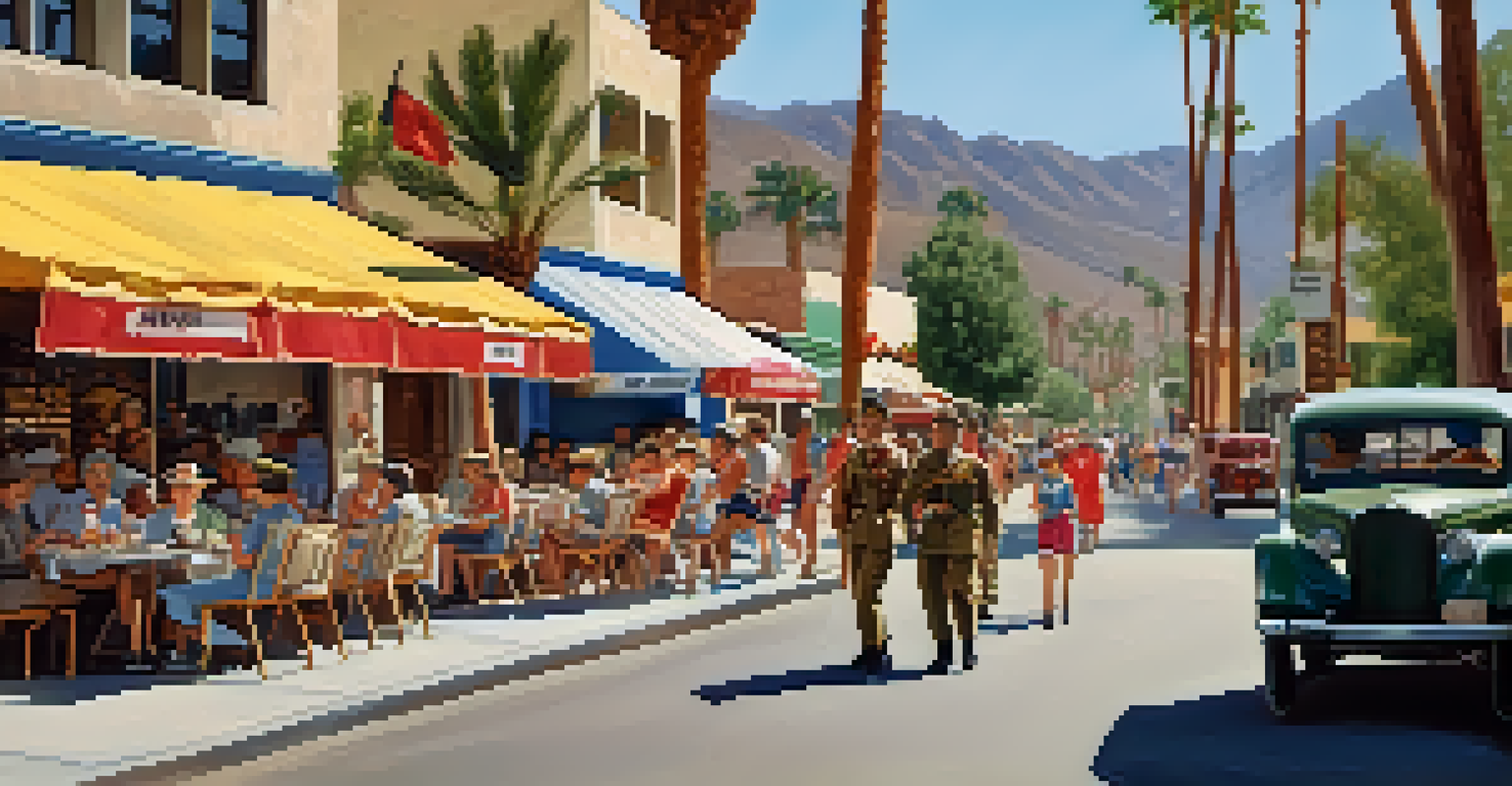The Impact of World War II on Palm Springs' Development

Palm Springs: A Desert Oasis Before the War
Before World War II, Palm Springs was already known as a glamorous getaway, attracting Hollywood stars and affluent visitors. Its unique desert landscape and warm climate made it a desirable retreat. However, the town's infrastructure and economy were still developing, relying heavily on tourism and agriculture. The pre-war years laid the foundation for what was to come, but little did anyone know how the war would catalyze significant changes.
The past is never dead. It's not even past.
Golf courses, luxury resorts, and mid-century modern homes were beginning to emerge, but the town's potential was largely untapped. Economic opportunities existed, yet they were often overshadowed by the seasonal nature of tourism. This backdrop set the stage for the transformation that World War II would bring to Palm Springs, reshaping both its physical landscape and its economic future.
With the war on the horizon, Palm Springs was about to become more than just a vacation spot; it was about to play a pivotal role in the military efforts that would change the course of history.
Military Presence: The Arrival of the Army Air Corps
As World War II unfolded, Palm Springs became an important training ground for the Army Air Corps. The establishment of the Palm Springs Army Air Field brought an influx of military personnel and resources to the area. This shift not only increased the population but also stimulated economic activity as local businesses adapted to serve the needs of soldiers and their families.

The military presence transformed Palm Springs, turning it into a bustling hub. Restaurants, shops, and entertainment venues flourished to accommodate the servicemen, leading to a vibrant community spirit. The newfound economic vitality was a stark contrast to the quieter days of pre-war Palm Springs, and it marked the beginning of a new identity for the town.
Military Growth Transformed Palm Springs
World War II shifted Palm Springs from a seasonal getaway to a bustling hub with a significant military presence, boosting local economy and infrastructure.
Furthermore, this military connection would later attract veterans looking to settle down after the war, forever altering the demographic makeup of Palm Springs.
The Boom in Infrastructure and Housing
The war brought about a pressing need for improved infrastructure in Palm Springs. Roads, schools, and utilities had to be developed rapidly to support the growing population. This development not only made the town more accessible but also laid the groundwork for future expansion, as city planners began to envision a more permanent community rather than a seasonal retreat.
History is not a burden on the memory but an illumination of the soul.
In addition, housing became a critical issue as the military personnel and their families arrived. To accommodate this influx, new neighborhoods sprang up, characterized by the iconic mid-century modern architecture that Palm Springs is famous for today. These homes were designed for comfort and functionality, embodying the spirit of the era while meeting the immediate needs of residents.
As a result, the post-war years saw a boom in construction that transformed the landscape of Palm Springs, setting the tone for its residential character in the decades that followed.
Cultural Shifts: From Military to Leisure
After the war, Palm Springs began transitioning back to its roots as a leisure destination. The returning veterans and their families were eager for relaxation and recreation, leading to a resurgence in tourism. Local businesses, previously focused on military needs, adapted again and began promoting the area’s natural beauty and recreational opportunities.
This cultural shift also brought a new wave of creativity and innovation. Artists, designers, and architects flocked to Palm Springs, drawn by its unique charm and burgeoning community. The mid-century modern movement thrived here, with many iconic structures being built during this time, reflecting the optimistic spirit of post-war America.
Post-War Shift to Leisure and Culture
After the war, the return of veterans revitalized tourism and sparked a cultural renaissance, leading to the flourishing of mid-century modern architecture.
This blend of military history and leisure culture created a unique identity for Palm Springs, where the remnants of its wartime past coexisted with a vibrant, artistic atmosphere.
Economic Diversification Beyond Tourism
World War II catalyzed an economic transformation in Palm Springs, moving beyond its reliance on tourism. With a growing population and improved infrastructure, local leaders began to explore various industries to sustain economic growth. This diversification was critical for the town's resilience, especially during off-peak tourist seasons.
New businesses emerged, including retail, healthcare, and entertainment, creating job opportunities and attracting a more permanent population. This shift not only stabilized the local economy but also enriched the community, fostering a sense of belonging among residents. The increased diversity of the economy allowed Palm Springs to flourish even when tourism fluctuated.
In essence, World War II prompted a reimagining of Palm Springs, shifting it from a seasonal getaway to a thriving community with a robust economic foundation.
Palm Springs: A Hub for Veterans
As soldiers returned home from the war, many chose Palm Springs as their new place of residence. The town offered affordable housing, a warm climate, and a friendly community, making it an attractive option for veterans and their families. This influx contributed to a population boom, shifting the demographics of the area and enriching its cultural fabric.
Local organizations began forming to support veterans, providing assistance in finding jobs, housing, and social integration. This camaraderie among veterans fostered a tight-knit community that valued shared experiences and mutual support. As a result, Palm Springs became known not only for its leisure but also as a place of healing and rejuvenation for those who had served.
Economic Diversification Emerged
The war catalyzed a move beyond tourism, fostering new industries and creating a more resilient and diverse economic foundation for Palm Springs.
The legacy of this veteran community continues to influence Palm Springs today, with annual events and memorials honoring their service, creating a profound connection between the town's past and present.
Legacy of World War II: Shaping Palm Springs Today
The impact of World War II on Palm Springs is still felt today, with its historical context woven into the town's identity. The mid-century modern architecture that flourished during the post-war years remains a defining feature of the area, attracting architecture enthusiasts and tourists alike. This style embodies the optimism of the era and serves as a reminder of the town’s transformation during a pivotal time in history.
Moreover, the diverse economy that emerged from the war years has laid a strong foundation for Palm Springs' continued growth. The blend of tourism, business, and community services keeps the town vibrant and adaptable to changing times. This evolution demonstrates how a community can rise from challenging circumstances and thrive in the long run.

Ultimately, the legacy of World War II has shaped not only the physical landscape of Palm Springs but also its spirit, influencing how residents and visitors experience this unique desert oasis today.